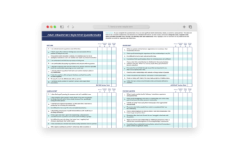Clinical breakthroughs don’t have to arrive with a perfectly-phrased insight or a memorable reframe.
Sometimes they arise through deep presence and attunement to the client’s experience.
This is the power of right-brain-to-right-brain communication—the felt sense between client and therapist that provides a disconfirming or restorative experience. It’s not something we “do” to clients; it’s something we co-create, often before language even enters the room.
Right-brain communication is subtle but foundational. It’s what allows clients to feel safe, feel seen, and feel understood—even if they can’t yet explain why.
What Every Therapist Should Know About Right-Brain Processing
Left and Right-Brain Processing
Let’s begin by dispelling a common neuroscience myth: left and right hemisphere processing isn’t about personality types. No one is “left-brained” or “right-brained.” Both hemispheres are active all the time—but they specialize in different kinds of processing. And these differences matter in therapy.
The left hemisphere tends to be logical, linear, and language-based. It focuses on familiar routines, spoken narratives, and analytical problem-solving. It organizes facts, tracks timelines, names emotions, and helps us construct meaning. It’s also where we manage our “social self”—the version of us shaped to perform, explain, and belong.
The right hemisphere, by contrast, is nonlinear, holistic, and deeply embodied. It reads facial expressions, tone of voice, gestures, and the rhythm of interaction. It’s responsible for our sense of emotional safety, our attachment circuitry, and our implicit memories—especially those encoded before we had language. It’s where the felt experience of self and other lives. Metaphor, intuition, and resonance belong here.
There are, of course, exceptions. In fact, a portion of the population has been found to have reversed hemispheric functions. Furthermore, some of these processes do incorporate both hemispheres, using a complex network of connections across the brain.
What is certain, is that good therapy integrates both hemispheres—practical and logical insights, with affective experiences, intuition, and felt-sense. But right-mode processing is often where lasting change becomes possible, especially when clients carry implicit memories or attachment wounds that were never verbalized in the first place.

Why the Right Hemisphere Matters in Therapy
Clients often come to therapy with a left-mode focus: a desire to make sense of things, understand what went wrong, or figure out how to solve a particular problem. This is completely valid—and often necessary. Insight, narrative, and problem-solving are stabilizing. They help build coherence and agency. But they aren’t always enough.
A client may say, “I know it wasn’t my fault,” while still feeling shame in their body. They may calmly describe their childhood as “normal,” while their voice quiets and posture slumps when talking about their caregivers. These are signs that the right hemisphere is holding something the left hemisphere can’t yet explain.
Bonnie Badenoch describes this as the logical mind being “in conflict with the unseen and unattended needs of the right mode yearnings.” A left-mode story may sound complete, but it can still leave the emotional truth untouched.
This is especially important when working with trauma and attachment wounds, which are often stored implicitly—beneath language, beneath narrative, beneath logic. To reach them, we need to meet the client in a different way.
This is where right-brain-to-right-brain communication becomes essential.
In this space, attunement can be more important than analysis—offering a presence that resonates with the client’s internal state and helps them feel emotionally held, perhaps for the first time.
And yet, in Western culture, this mode of interaction is often undervalued. Logic, reason, and verbal clarity are seen as signs of intelligence and competence. Emotional presence, intuition, and nonverbal knowing are easily dismissed as “unscientific” or “soft.” But in the therapy room—especially with developmental trauma—these so-called “soft” skills are the very heart of the work.
What Right-Mode Communication Looks Like
Right-brain communication isn’t a technique. It’s a mode of presence—an ongoing, nonverbal exchange that helps regulate the client’s nervous system and builds the safety required for deeper work. It happens beneath words, often before either party is fully conscious of it.
In therapy, this communication flows through subtle cues:
- Eye gaze: Is it soft, direct, indirect, inviting?
- Prosody: The musicality of the therapist’s voice—tone, rhythm, cadence
- Facial expression: Responsive, attuned, emotionally congruent
- Gestures and posture: Are you physically open, turned toward, settled?
- Pacing: Are you allowing space for affect to rise and settle?
- Energetic stance: What does your body convey about safety, availability, or regulation?
These cues express empathy, and, perhaps more importantly, they transmit safety. And the right hemisphere of the client’s brain is tracking them constantly, whether or not they’re consciously aware of it.
Attunement Over Intervention
A client begins describing a recent conflict with their partner. Their words are clipped, eyes averted. There’s tension in the space. Before jumping in to analyze the dynamic or offer a reframe, you take a beat to attune — slowing your breath, softening your posture. These cues can signal safety to their nervous system, creating a moment where they can begin to settle and stay present.
Another client may glaze over mid-description. Their face goes flat, eyes distant. Rather than immediately trying to pull them back with questions or topic shifts, you first anchor yourself and meet the moment — perhaps lowering your tone, softening your gaze, or gently naming what you’re noticing. This presence invites them to return on their own timeline, while letting them know you’re right here with them.
Attunement isn’t passive. It’s an active stance that prepares the ground for whatever comes next — whether that’s a validating reflection, gentle curiosity, or an intervention to support regulation.

Integration: The Goal Isn’t Either/Or
Right-mode communication may open the door, but healing deepens when both hemispheres are invited to participate. When a client sticks only to naming the problem without feeling, therapy can become surface-level, hollow conversations. But feeling without naming can lead to flooding or overwhelm. The key is linking the two—connecting affective, implicit experience with reflective, explicit understanding.
This is where left-mode processing becomes essential. Once the nervous system begins to settle through attuned presence, the client can begin to make meaning of what’s happening. They may name a feeling, connect it to a memory, or begin to revise an internal narrative. That movement—from implicit to explicit, from felt to understood—is where lasting transformation becomes possible.
Effective therapy often oscillates between these poles:
- Right-mode: sensing, feeling, experiencing
- Left-mode: naming, reflecting, organizing
When both hemispheres are online, the client can access more of themselves—body, mind, memory, emotion, imagination—and begin to move through their world with greater fluidity and internal alignment.
Attunement as a Foundation
Right-brain communication forms the foundation of the therapeutic relationship. Before we intervene, interpret, or explore, we are always communicating—through our breath, our eyes, our tone, our presence.
Clients are tracking these cues constantly, even if they can’t name them. And often, it’s the unspoken moments when the nervous system feels met and accompanied, that allow something new to unfold.
As therapists, we can start by noticing what’s already happening in the space between us and our clients. The pace of speech, the quality of silence, and the way someone shifts in their seat or softens in their gaze.
These may seem like small moments. But they are often where connection is built, defenses soften, and healing can deepen.





Ready to Begin Your Healing Journey?
Browse on-demand courses and begin learning from top experts today!

